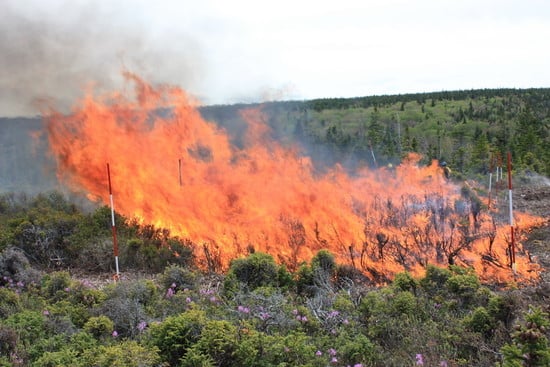Fire Behaviour Observation in Shrublands in Nova Scotia, Canada and Assessment of Aids to Operational Fire Behaviour Prediction
Abstract
:1. Introduction
2. Materials and Methods
2.1. Burn Units and Fire Weather Station Establishment
2.2. Fuel Moisture
2.2.1. Live Moisture Content (LMC) Spring 2014
2.2.2. LMC Summer 2017
2.2.3. Dead Moisture Content (MCdead)
2.3. Vegetation Composition and Height
2.4. Fuel Load and Fuel Consumption
2.5. Fire Behaviour
2.5.1. Rate of Spread (ROS)
2.5.2. ROS Model Comparison
2.5.3. Fire Intensity and Flame Length (m) Relationships Models
2.5.4. Heat of Combustion
3. Results
3.1. Fuel Load, Vegetation Height and Bulk Density
3.2. Fuel Moisture
3.2.1. Live Moisture Content (LMC), Spring 2014
3.2.2. Live Moisture Content (LMC), Summer 2017
3.2.3. Dead Moisture Content (MCdead)
3.3. Low Heat of Combustion
3.4. Fire Behaviour
3.4.1. Fuel Consumption
3.4.2. Fire Spread Rate
3.4.3. ROS Model Comparison
3.4.4. Fire Intensity and Flame Length
4. Discussion
Author Contributions
Funding
Acknowledgments
Conflicts of Interest
Appendix A
| Unit | Date | Start Time | End Time | 10 m WS (Top of Previous Hour) * | 10 m WS (Top of Following Hour) * | 10 m WS (Top of 2nd Previous Hour) * | Max Gust over Both Hours | 10 m WS During Burn (Via radio) ** | 10m WS Final |
|---|---|---|---|---|---|---|---|---|---|
| 7 | 06/10/2014 | 15:01:03 | 15:06:12 | 16 | 13 | 31 | na | 16 | |
| 12 | 06/10/2014 | 15:45:47 | 15:56:00 | 16 | 13 | 31 | na | 13 | |
| 17 | 06/10/2014 | 16:27:36 | 16:41:32 | 13 | 13 | 20 | na | 13 | |
| 8 | 06/10/2014 | 18:57:46 | 19:13:31 | 15 | 11 | 6 | 22 | na | 11 |
| 9 | 06/10/2014 | 19:35:00 | 20:18:00 | 11 | 6 | 9 | 12 | na | 9 |
| 32 | 06/12/2014 | 11:27:37 | 11:47:31 | 12 | 12 | 24 | na | 12 | |
| 27 | 06/12/2014 | 13:28:28 | 13:42:29 | 9 | 9 | 10 | na | 9 | |
| 22 | 06/12/2014 | 15:14:10 | 15:23:06 | 8 | 7 | 8 | na | 8 | |
| 13 | 07/14/2017 | 10:58:40 | 11:02:47 | 13 | 14 | 22 | na | 14 *** | |
| 14 | 07/14/2017 | 13:21:46 | 13:31:36 | 16 | 12 | 28 | 14 | 14 | |
| 24 | 07/14/2017 | 15:13:24 | 15:36:45 | 20 | 18 | 29 | 20 | 20 | |
| 25 | 07/14/2017 | 17:08:04 | 17:18:22 | 15 | 16 | 28 | 15 | 15 | |
| 19 | 07/14/2017 | 18:05:24 | 18:30:30 | 16 | 15 | 27 | na | 16 | |
| 23 | 07/15/2017 | 10:52:03 | 11:08:14 | 16 | 20 | 20 | 20 | 20 | |
| 18 | 07/15/2017 | 12:15:33 | 12:25:29 | 23 | 26 | 42 | 20 | 20 |
Appendix A.1. Live Moisture Content
| Spring 2014 | Load (kg/ m2) | Load Proportion | Measured LMC (%) | Fractional Contribution LWMC (%) |
|---|---|---|---|---|
| Livefoliage | 0.3 | 27 | 183 (s.d. 31) | 49 |
| Live stems 0–1 cm | 0.8 | 73 | 101 (s.d. 5) | 73 |
| Total | 1.1 | 100 | 122 |
| Summer 2017 | Load (kg/m2) | Load Proportion | Measured LMC (%) | Fractional Contribution LWMC (%) |
|---|---|---|---|---|
| Live shrub foliage | 0.1 (s.d. 0.06) | 11 | 207 (s.d. 88) | 23 |
| Live spruce foliage | 0.3 (s.d. 0.03) | 21 | 155 (s.d. 25) | 33 |
| Live stems 0–1 cm | 0.8 (s.d.0.19) | 68 | 104 (s.d. 7) | 71 |
| Total | 1.2 (s.d. 0.26) | 100 | 127 |
Appendix A.2. Within Plot Layout

| Burn Unit | Pre-Load * (kg/m2) | Post Load 0–1 cm (kg/m2) | Estimated Fuel Consumption (kg/m2) ** |
|---|---|---|---|
| 13 | 3.15 (s.d. 1.10) | 0.18 (s.d 0.08) | 2.96 (0.81) |
| 14 | 2.09 (s.d. 0.57) | 0.09 (s.d. 0.02) | 2.00 (0.57) |
| 18 | 3.05 (s.d. 1.06) | 0.14 (s.d. 0.06) | 2.91 (1.06) |
| 19 | 3.12 (s.d. 1.87) | 0.26 (s.d. 0.21) | 2.87 (1.88) |
| 23 | 3.19 (s.d. 1.48) | 0.12 (s.d. 0.09) | 3.07 (1.48) |
| 24 | 4.86 (s.d. 3.57) | 0.33 (s.d. 0.28) | 4.52 (3.58) |
| 25 | 2.77 (s.d.0.62) | 0.15 (s.d. 0.07) | 2.61 (0.52) |
| Mean | 3.17 (s.d. 0.84) | 0.18 (s.d. 0.09) | 2.99 (0.84) |
| Spring (n = 6) | |||
|---|---|---|---|
| Model | r (p) | Bias * | MAE * |
| Anderson et al. (2015) [5]: bulk density | 0.85 (0.03) | −43.0 | 3.0 |
| Anderson et al. (2015) [5]: height | 0.84 (0.04) | −2.7 | 2.7 |
| Catchpole et al. (1998) [18] | 0.84 (0.04) | 0.54 | 0.61 |
| Davies et al. (2009) [2] | 0.84 (0.04) | 1.7 | 1.7 |
| Fernandes et al. (2000) [3]: height | 0.85 (0.03) | −2.5 | 2.5 |
| Fernandes (2001) [4] | 0.83 (0.03) | −2.6 | 2.6 |
| US BEHAVE [13] | 0.76 (0.08) | 3.5 | 3.5 |
| FBP (O-1b) [14] | 0.97 (0.0009) | 5.1 | 5.5 |
| FBP (O-1b-modified) [14,15] ** | 0.86 (0.06) | 1.5 | 2.9 |
| Burn Unit | Litter | Live Stems—0–1 | Live Stems—1–7 | Live Foliage—Coniferous | Live Foliage—Shrub | Dead Stems—0–1 | Dead Stems—1–7 | Total Load Total |
|---|---|---|---|---|---|---|---|---|
| 13 | 0.56 (0.36) | 1.07 (0.24) | 0.58 (0.62) | 0.34(0.19) | 0.14(0.04) | 0.27 (0.09) | 0.17(0.09) | 3.15 (1.1) |
| 14 | 0.89 (0.28) | 0.56 (0.23) | 0.14 (0.23) | 0.2 (0.12) | 0.09(0.04) | 0.09(0.04) | 0.11 (0.12) | 2.09 (0.57) |
| 18 | 1.01 (0.35) | 0.75(0.38) | 0.56(0.58) | 0.30 (0.30) | 0.10 (0.03) | 0.11 (0.08) | 0.21 (0.25) | 3.04 (1.06) |
| 19 | 1.10 (0.68) | 0.81(0.25) | 0.51 (0.71) | 0.25(0.18) | 0.19(0.10) | 0.12(0.07) | 0.14 (0.25) | 3.12 (1.87) |
| 23 | 0.81 (0.71) | 0.91 (0.30) | 0.37 (0.30) | 0.24 (0.11) | 0.13(0.09) | 0.25(0.11) | 0.47(0.45) | 3.19 (1.48) |
| 24 | 2.05 (1.71) | 1.01(0.20) | 0.48 (0.44) | 0.33(0.14) | 0.13 (0.04) | 0.33 (0.26) | 0.51 (0.66) | 4.86 (3.57) |
| 25 | 0.98 (0.20) | 0.82 (0.30) | 0.34(0.26) | 0.20(0.11) | 0.14(0.04) | 0.15(0.06) | 0.15 (0.24) | 2.77 (0.62) |
| 2014 mean | 3.5 ± 1.17 | |||||||
| 2017 mean | 3.17 ± 0.83 |
| Temperature (Degrees C) | ||||||
|---|---|---|---|---|---|---|
| RH (%) | 5 | 10 | 15 | 20 | 25 | 30 |
| 10 | 95 | 95 | 96 | 97 | 97 | 98 |
| 20 | 92 | 92 | 93 | 94 | 95 | 96 |
| 30 | 89 | 90 | 91 | 92 | 93 | 94 |
| 40 | 87 | 88 | 89 | 90 | 91 | 92 |
| 50 | 86 | 86 | 87 | 88 | 89 | 90 |
| 60 | 84 | 85 | 86 | 86 | 87 | 88 |
| 70 | 82 | 83 | 84 | 85 | 85 | 86 |
| 80 | 80 | 81 | 82 | 82 | 83 | 84 |
| 90 | 77 | 78 | 78 | 79 | 80 | 81 |
| 100 | 71 | 72 | 72 | 73 | 74 | 74 |
References
- Bridgland, J.R.; Cook, R.; Power, R.; Pardy, B. Fire history of Northern Cape Breton: GIS analysis of Biophysical Data. In Ecosystem Monitoring and Protected Areas, Proceedings of The 2nd International Conference on Science and the Management of Protected Areas, Dalhousie University, Halifac, NC, Canada, 16–20 May 1994; Herman, T.B., Bondrup-Nielson, S., Willison, J.H.M., Munro, N.W.O., Eds.; Sciences and Management of Protected Areas Association, Centre for Wildlife and Conservation Biology, Acadia University: Wolfville, NS, Canada, 1995; pp. 398–406. [Google Scholar]
- Davies, G.M.; Legg, C.J.; Smith, A.A.; McDonald, A.J. Rate of Spread of fires in Calluna vulgaris-dominated moorlands. J. Appl. Ecol. 2009, 46, 1054–1063. [Google Scholar] [CrossRef]
- Fernandes, P.; Anderson, W.; Rego, F.C. Shrubland fire behaviour modelling with microplot data. Can. J. For. Res. 2000, 30, 889–899. [Google Scholar] [CrossRef]
- Fernandes, P. Fire spread prediction in shrub fuels in Portugal. For. Ecol. Manag. 2001, 144, 67–74. [Google Scholar] [CrossRef]
- Anderson, W.R.; Cruz, M.; Fernandes, P.M.; McCaw, L.; Vega, J.A.; Bradstock, R.A.; Fogarty, L.; Gould, J.; McCarthy, G.; Marsden-Smedley, J.B.; et al. A generic, empiral-based model for predicting rate of fire spread in shrublands. Int. J. Wildland Fire 2015, 24, 443–460. [Google Scholar] [CrossRef] [Green Version]
- Cruz, M.G.; Gould, J.S.; Alexander, M.E.; Sullivan, A.L.; McCaw, W.L.; Matthews, S. A Guide to Rate of Fire Spread Models for Australian Vegetation; CSIRO Land and Water Flagship: Canberra, Australia, 2015; 123p. [Google Scholar]
- Baeza, M.J.; Santana, V.M.; Pausas, J.G.; Vallejo, V.R. Successional trends in standing dead biomass in Mediterranean basin species. J. Veg. Sci. 2011, 22, 467–474. [Google Scholar] [CrossRef] [Green Version]
- Van Wagner, C.E. Development and Structure of the Canadian Forest Fire Weather Index System; Forestry Technical Report 35; Canadian Forestry Service: Ottawa, ON, Canada, 1987; 35p.
- Oikle, D.; Pepin, A.-C.; Wotton, M.; Morrison, I.; Kafka, V. Collection of Data for Nova Scotia Special. Moisture Content and Fuel Load; Nova Scotia Department of Natural Resources: Truro, NS, Canada, 2011. [Google Scholar]
- Van Wagner, C.E. A Method of Computing Fine Fuel Moisture Content Throughout the Diurnal Cycle; Information Report PS-X-69; Canadian Forest Service, Petawawa Forest Experiment Station: Chalk River, ON, Canada, 1977.
- Lutes, D.C.; Keane, R.E.; Caratti, J.F.; Key, C.H.; Benson, N.C.; Sutherland, S.; Gangi, L.J. FIREMON: Fire Effects Monitoring and Inventory System; U.S. Department of Agriculture, Forest Service: Washington, DC, USA, 2006.
- Simard, A.J.; Eenigenburg, J.E.; Adams, K.B.; Nissen, R.L., Jr.; Deacon, A.G. A general procedure for sampling and analyzing wildland fire spread. For. Sci. 1984, 30, 51–64. [Google Scholar] [CrossRef]
- Andrews, L. BehavePlus Fire Modeling System, Version 5.0; U.S. Department of Agriculture, Forest Service: Washington, DC, USA, 2009; 107p.
- Forestry Canada. Development and Structure of the Canadian Forest Fire Behavior Prediction System; Information Report ST-X-3; Forestry Canada, Headquarters, Fire Danger Group and Science and Sustainable Development Directorate: Ottawa, ON, Canada, 1992; 64p.
- Kidnie, S.; Wotton, B.M. Characterization of the Fuel and Fire Environment in Southern Ontario’s Tallgrass Prairie. Int. J. Wildland Fire 2015, 24, 1118–1128. [Google Scholar] [CrossRef]
- Byram, G.M. Combustion of forest fuels. In Forest Fire Control and Use; Davis, K.P., Ed.; McGraw-Hill: New York, NY, USA, 1959; pp. 61–89. [Google Scholar]
- Alexander, M.; Cruz, M. Interdependencies between flame length and fireline intensity in predicting crown fire initiation and crown scorch height. Int. J. Wildland Fire 2012, 21, 95–113. [Google Scholar] [CrossRef]
- Catchpole, W.R.; Bradstock, R.A.; Choate, J.; Fogarty, L.G.; Gellie, N.; McCarthy, G.J.; McCaw, W.L.; Marsden-Smedley, J.B.; Pearce, G. Cooperative development of equations for heathland fire behaviour. In Proceedings of the 3rd International Conference on Forest Fire Research, Luso, Portugal, 16–20 November 1998. [Google Scholar]
- Vega, J.A.; Cuiñas, P.; Fonturbel, T.; Perez-Gorostiaga, P.; Fernandez, C. Predicting fire behaviour in Galician (NW Spain) shrubland fuel complexes. In Proceedings of the III International Conference on Forest Fire Research and 14th Conference on Fire and Forest Meteorology, Luso, Portugal, 16–20 November 1998; Viegas, D.X., Ed.; University of Coimbra: Coimbra, Portugal; Volume II, pp. 713–728. [Google Scholar]
- Nelson, R.M.; Adkins, C.W. Flame characteristics of wind-driven surface fires. Can. J. For. Res. 1986, 16, 1293–1300. [Google Scholar] [CrossRef]
- Chrosciewicz, Z. Foliar heat content variations in four coniferous tree species of central Alberta. Can. J. For. Res. 1986, 16, 152–157. [Google Scholar] [CrossRef]
- Wotton, B.M.; Beverly, J.L. Stand specific litter moisture content calibrations for the Canadian Fine Fuel Moisture Code. Int. J. Wildland Fire 2007, 16, 463–472. [Google Scholar] [CrossRef]
- Johnston, D.C.; Turetsky, M.R.; Benscotter, B.W.; Wotton, B.M. Fuel load, structure and fire behaviour in forested boreal bogs. Can. J. For. Res. 2015, 45, 888–899. [Google Scholar] [CrossRef]
- Stocks, B.J.; Alexander, M.E.; Wotton, B.M.; Stefner, C.N.; Flannigan, M.D.; Taylor, S.W.; Lavoie, N.; Mason, J.A.; Hartley, G.R.; Maffey, M.E.; et al. Crown fire behaviour in a northern jack pine-black spruce forest. Can. J. For. Res. 2004, 34, 1548–1560. [Google Scholar] [CrossRef] [Green Version]
- Wotton, B.M.; Alexander, M.E.; Taylor, S.W. Updates and revisions to the Canadian Forest Fire Behaviour Prediction System. Nat. Res. Can. Can. For. Serv. Great Lakes Forestry Centre Info. 2009, 1, 47. [Google Scholar]
- Cruz, M.G.; Alexander, M.E.; Wakimoto, R.H. Development and testing of models for predicting crown fire rate in conifer forest stands. Can. J. For. Res. 2005, 35, 1626–1639. [Google Scholar] [CrossRef]
- Blackmarr, W.H.; Flanner, W.B. Seasonal and Diurnal Variation in Moisture Content of Six Species of Pocosin Shrubs; Research Paper SE-RP-33; USDA-Forest Service, Southeastern Forest Experiment Station: Asheville, NC, Canada, 1968; 11p.
- Davies, G.M.; Legg, C.J.; Hamilton, A.; Smith, A.A. Developing shrub fire behaviour models in oceanic climate: Burning in the British Uplands. For. Ecol. Manag. 2006, 234 (Suppl. 1-S107), 1–15. [Google Scholar] [CrossRef] [Green Version]
- Bushfire Cooperative Research Group. Fire Behaviour Workshop State of Knowledge-Australasian Update; Bushfire Research Group, Ensis—CSIRO: Yarralumla, Australia, 2007. [Google Scholar]
- Taylor, S.W.; Alexander, M.E. Field Guide to the Canadian Forest Fire Behavior Prediction (FBP) System, 2nd ed.; Special Report; Natural Resources Canada, Canadian Forest Service, Northern Forestry Centre: Edmonton, AB, Canada, 2016; Volume 11, p. 132. [Google Scholar]

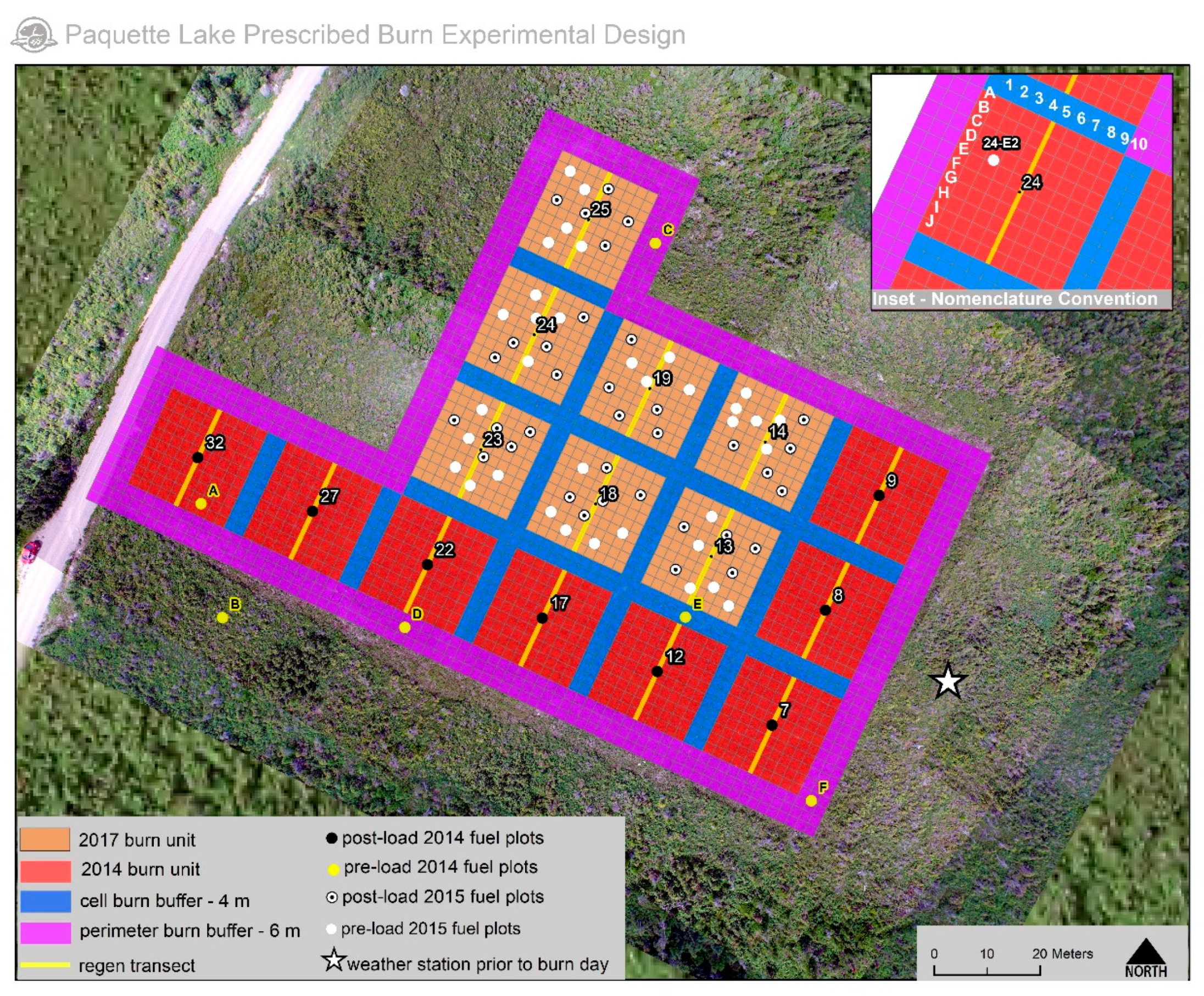


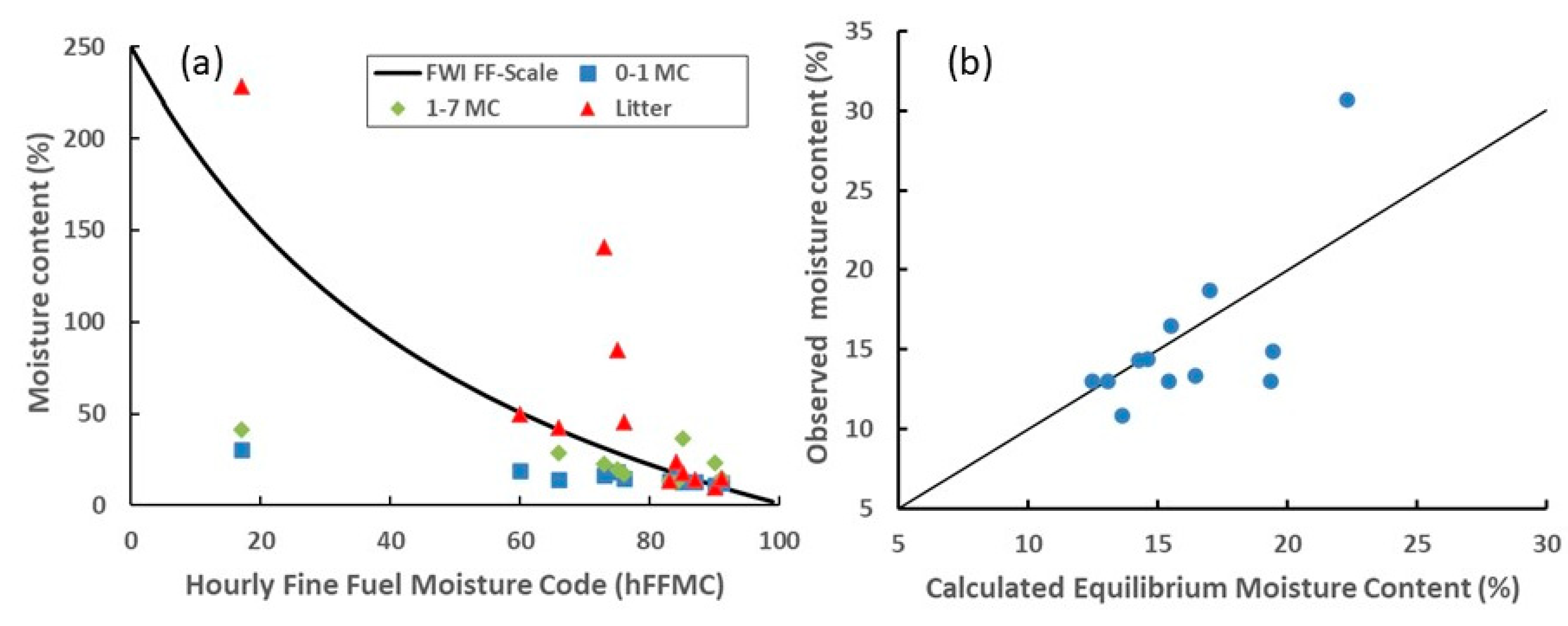
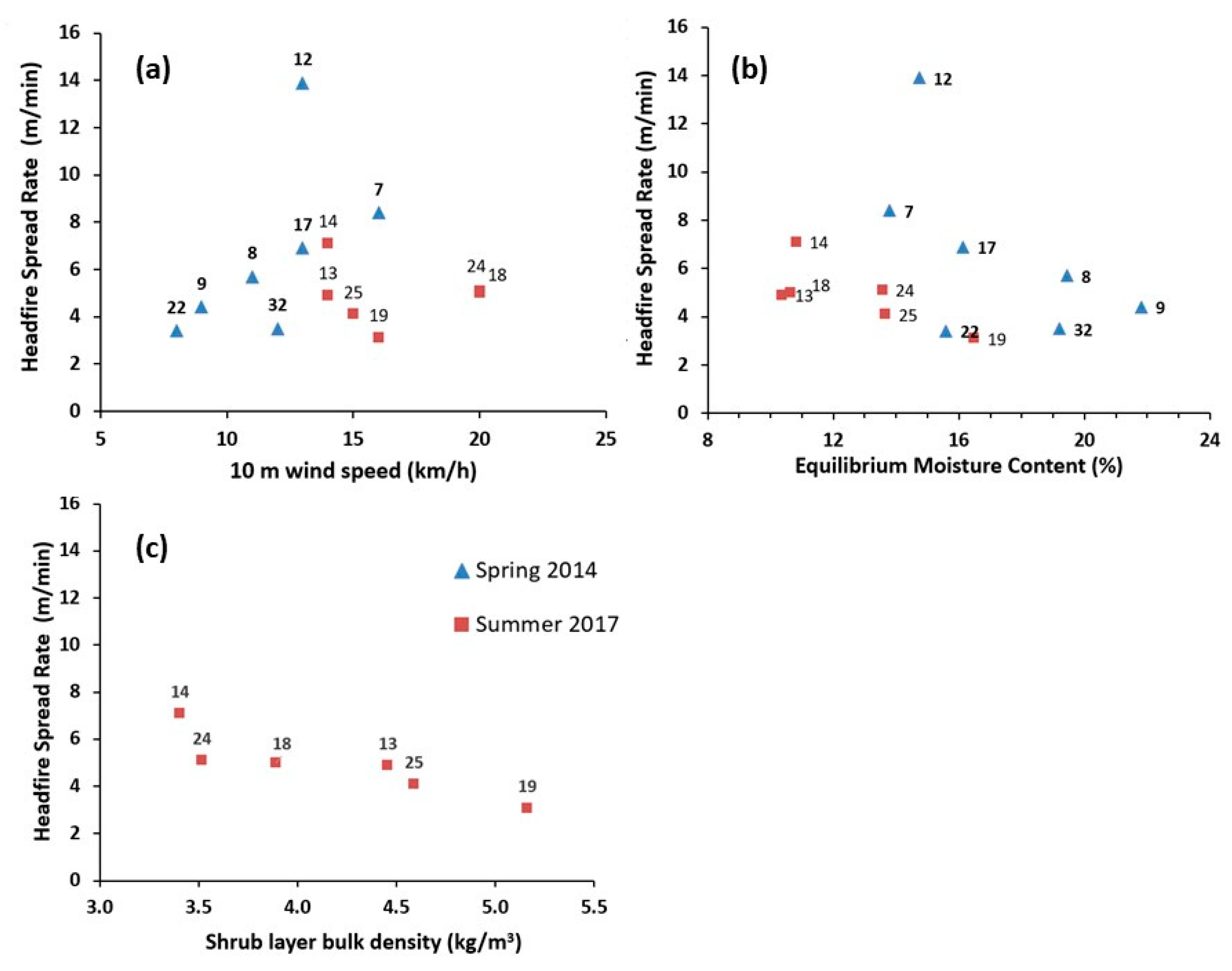
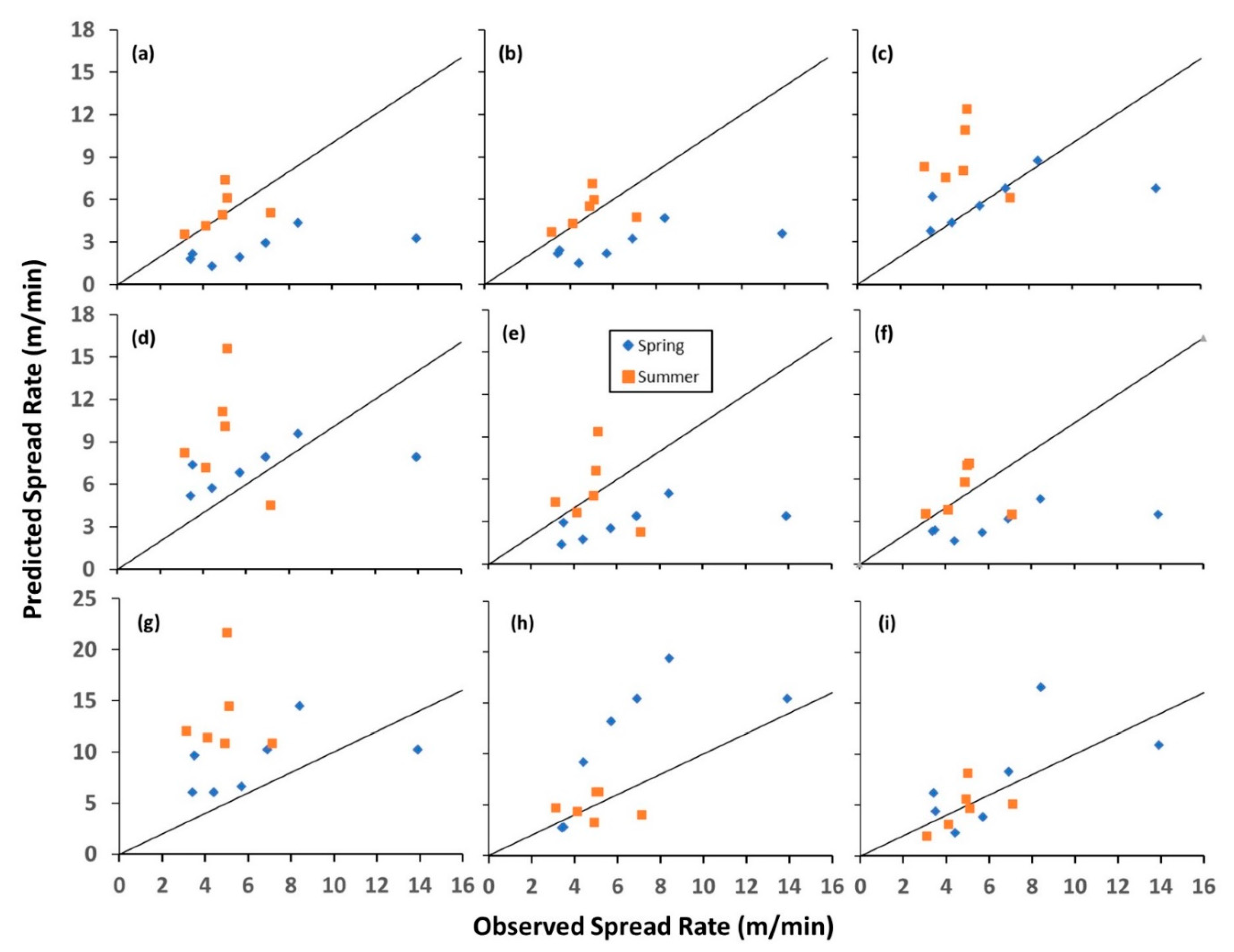

| Unit | Date | Temp (◦C) | RH (%) | 10 m WS (kph) | HFFMC | HISI | BUI | Fuel Load (kg/m2) | Vegetation Height (m) | Bulk Density of Shrub Layer * (kg/m3) | Frontal ROS (m/min) | Average Frontal Flame Length (m) | Average Frontal Intensity Flame Length ** (kw/m) | Fuel Consumption (kg/m2) | Frontal Intensity Byram Equation (kW/m) | EMC *** (%) |
|---|---|---|---|---|---|---|---|---|---|---|---|---|---|---|---|---|
| 7 | 06/10/2014 15:01 | 19.4 | 50 | 16 | 88 | 7.4 | 23 | 3.34 ± 1.1 | 0.5 | 5 | 8.4 | 4.1 | 5583 | 2.3 | 6025 | 13.8 |
| 12 | 06/10/2014 15:45 | 18.4 | 54 | 13 | 88 | 6.4 | 23 | 3.34 ± 1.1 | 0.5 | 5 | 13.9 | 4.3 | 6192 | 2.1 | 8750 | 14.7 |
| 17 | 06/10/2014 16:27 | 15.9 | 59 | 13 | 88 | 6.1 | 23 | 3.34 ± 1.1 | 0.5 | 5 | 6.9 | 4.4 | 6510 | 3.2 | 6949 | 16.1 |
| 8 | 06/10/2014 18:57 | 12.3 | 72 | 11 | 88 | 5.2 | 23 | 3.34 ± 1.1 | 0.5 | 5 | 5.7 | 3.7 | 4466 | 2.4 | 4311 | 19.4 |
| 9 | 06/10/2014 19:35 | 10.8 | 80 | 9 | 87 | 3.7 | 23 | 3.34 ± 1.1 | 0.5 | 5 | 4.4 | 3.3 | 3483 | 3.1 | 4226 | 21.8 |
| 32 | 06/12/2014 11:27 | 12.4 | 71 | 12 | 79 | 1.9 | 25 | 3.34 ± 1.1 | 0.5 | 5 | 3.5 | 3.1 | 3040 | 1.9 | 2099 | 19.2 |
| 27 **** | 06/12/2014 13:28 | 14 | 63 | 9 | 80 | 1.8 | 27 | 3.34 ± 1.1 | 0.5 | 5 | 2.0 | 2.8 | 2437 | 3.0 | 1880 | 17.2 |
| 22 | 06/12/2014 15:14 | 14.7 | 55 | 8 | 81 | 1.9 | 27 | 3.34 ± 1.1 | 0.5 | 5 | 3.4 | 3.3 | 3483 | 3.1 | 3288 | 15.6 |
| 13 | 07/14/2017 10:58 | 22.2 | 35 | 14 | 88 | 7.1 | 51 | 3.15 ± 1.1 | 0.58 | 4.46 | 4.9 | 4.0 | 5291 | 3.1 | 4782 | 10.4 |
| 14 | 07/14/2017 13:21 | 23.5 | 38 | 14 | 89 | 7.7 | 51 | 2.09 ± 0.6 | 0.35 | 3.41 | 7.1 | 5.0 | 8595 | 1.5 | 3313 | 10.8 |
| 24 | 07/14/2017 15:13 | 20.1 | 51 | 20 | 89 | 11 | 51 | 4.86 ± 3.6 | 0.58 | 3.52 | 5.1 | 6.0 | 12,776 | 3.0 | 4853 | 13.6 |
| 25 | 07/14/2017 17:08 | 20 | 57 | 15 | 89 | 8.6 | 51 | 2.77 ± 0.6 | 0.44 | 4.59 | 4.1 | 4.0 | 5291 | 2.5 | 3251 | 13.7 |
| 19 | 07/14/2017 18:05 | 18.2 | 63 | 16 | 89 | 8.6 | 51 | 3.12 ± 1.9 | 0.46 | 5.16 | 3.1 | 3.0 | 2831 | 1.5 | 1475 | 16.5 |
| 23 **** | 07/15/2017 10:52 | 23.2 | 37 | 20 | 89 | 11.1 | 51 | 3.19 ± 1.5 | 0.48 | 5.84 | 1.5 | 2.0 | 1173 | 2.1 | 999 | 10.6 |
| 18 | 07/15/2017 12:15 | 22.7 | 36 | 20 | 89 | 13.8 | 51 | 3.05 ± 1.1 | 0.46 | 3.89 | 5.0 | 4.5 | 6836 | 1.9 | 3013 | 10.6 |
| Fuel Component | Average Low Heat of Combustion (100% MC) |
|---|---|
| Kalmia new foliage | 19.03 (s.d. 0.46) |
| Kalmia winter | 20.23 (s.d. 2.26) |
| Rhodara | 19.45 (s.d. 1.34) |
| Stems mixed | 19.39 (s.d. 2.68) |
| Duff | 15.86 (s.d. 0.81) |
| Model | Spring (n = 7) | Summer (n = 6) | ||||
|---|---|---|---|---|---|---|
| r (p) * | Bias * | MAE * | r (p) | Bias | MAE | |
| Anderson et al. (2015) [5]: bulk density | 0.67 (0.10) | 4.1 | 4.2 | 0.42 (0.4) | −1.0 | 1.6 |
| Anderson et al. (2015) [5]: height | 0.67 (0.10) | 3.8 | 3.8 | 0.34 (0.5) | −0.5 | 1.2 |
| Catchpole et al. (1998) [18] | 0.58 (0.17) | 0.54 | 3.1 | −0.2 (0.7) | 4.0 | 4.4 |
| Davies (2009) [2] | 0.58 (0.17) | −0.63 | 2.4 | 0.22 (0.9) | 3.8 | 3.9 |
| Fernandes et al. (2000) [3]: height | 0.57 (0.18) | 3.7 | 3.7 | −0.17 (0.75) | 0.34 | 2.1 |
| Fernandes (2001) [4] | 0.64 (0.12) | 3.8 | 2.9 | −0.07 (0.88) | 0.12 | 1.4 |
| US BEHAVE [13] | 0.57 (0.23) | −2.4 | 3.5 | −0.02 (0.97) | 8.7 | 8.7 |
| FBP (O-1b) [14] | 0.71 (0.07) | −4.6 | 5.0 | −0.08 (0.87) | −0.02 | 1.5 |
| FBP (O-1b-modified) [14,15] ** | 0.64 (0.12) | −0.9 | 2.9 | 0.52 (0.28) | −0.09 | 1.4 |
© 2020 by the authors. Licensee MDPI, Basel, Switzerland. This article is an open access article distributed under the terms and conditions of the Creative Commons Attribution (CC BY) license (http://creativecommons.org/licenses/by/4.0/).
Share and Cite
Pepin, A.-C.; Wotton, M. Fire Behaviour Observation in Shrublands in Nova Scotia, Canada and Assessment of Aids to Operational Fire Behaviour Prediction. Fire 2020, 3, 34. https://doi.org/10.3390/fire3030034
Pepin A-C, Wotton M. Fire Behaviour Observation in Shrublands in Nova Scotia, Canada and Assessment of Aids to Operational Fire Behaviour Prediction. Fire. 2020; 3(3):34. https://doi.org/10.3390/fire3030034
Chicago/Turabian StylePepin, Anne-Claude, and Mike Wotton. 2020. "Fire Behaviour Observation in Shrublands in Nova Scotia, Canada and Assessment of Aids to Operational Fire Behaviour Prediction" Fire 3, no. 3: 34. https://doi.org/10.3390/fire3030034



